

Puerh.fr. A Guide to Puerh Tea. Pu-erh tea. China famous tea. China's Famous Teas (中国名茶) or the Ten Great Chinese Teas (中国十大名茶) is a list of the ten most notable Chinese teas.
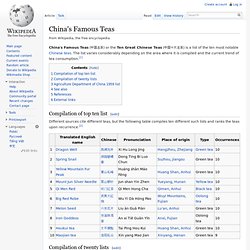
The list varies considerably depending on the area where it is compiled and the current trend of tea consumption.[1] Compilation of top ten list[edit] Different sources cite different teas, but the following table compiles ten different such lists and ranks the teas upon recurrence.[2] Compilation of twenty lists[edit] Huang Shan Mao Feng tea. Huangshan Maofeng tea (黄山毛峰) is a green tea produced in south eastern interior Anhui province of China.

The tea is one of the most famous teas in China and can almost always be found on the China Famous Tea list. The tea is grown near Huangshan (Yellow Mountain), which is home to many famous varieties of Green Tea. Huangshan Mao Feng Tea's English translation is "Yellow Mountain Fur Peak" due to the small white hairs which cover the leaves and the shape of the processed leaves which resemble the peak of a mountain. The best teas are picked in the early Spring before China's Qingming Festival. When picking the tea, only the new tea buds and the leaf next to the bud are picked.
Tieguanyin. Tieguanyin (simplified Chinese: 铁观音; traditional Chinese: 鐵觀音; Mandarin Pinyin: tiěguānyīn; Jyutping: tit3 gun1 jam1; Pe̍h-ōe-jī: Thih-koan-im; literally "Iron Guanyin") is a premium variety of Chinese oolong tea originated in the 19th century in Anxi in Fujian province.[1] Tieguanyin produced in different areas of Anxi have different gastronomic characteristics.[2] Production has since extended to many regions even outside of China.[2] Name[edit] The tea is named after the Chinese Goddess of Mercy Guanyin, who is known in Japan as Kannon and in Korea as Guam-eum.
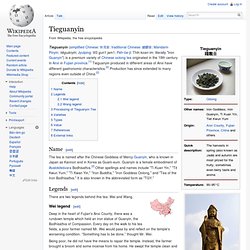
Guanyin is a female embodiment of Avalokiteśvara Bodhisattva.[2] Other spellings and names include "Ti Kuan Yin," "Tit Kwun Yum," "Ti Kwan Yin," "Iron Buddha," "Iron Goddess Oolong," and "Tea of the Iron Bodhisattva. " It is also known in the abbreviated form as "TGY. " Bi Luo Chun tea. Biluochun (Chinese: 碧螺春) is a famous green tea originally grown in the Dongting mountain region near Lake Tai, Jiangsu, China.
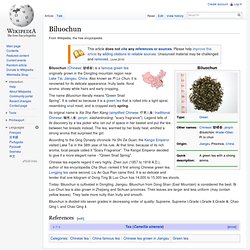
Also known as Pi Lo Chun, it is renowned for its delicate appearance, fruity taste, floral aroma, showy white hairs and early cropping. The name Biluochun literally means "Green Snail Spring". Longjing tea. Longjing tea (simplified Chinese: 龙井茶; traditional Chinese: 龍井茶; pinyin: lóngjǐng chá), sometimes called by its literal translated name Dragon Well tea, is a variety of pan-roasted green tea[1] from Hangzhou, Zhejiang Province, China where it is produced mostly by hand and has been renowned for its high quality, earning the China Famous Tea title.
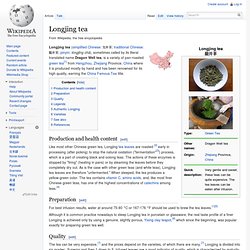
Production and health content[edit] Like most other Chinese green tea, Longjing tea leaves are roasted [2] early in processing (after picking) to stop the natural oxidation ("fermentation"[3]) process, which is a part of creating black and oolong teas. The actions of these enzymes is stopped by "firing" (heating in pans) or by steaming the leaves before they completely dry out.
Lu'an Melon Seed Tea. Examples of Lu'an Melon Seed tea Melon Seed tea Lu'an Melon Seed (Chinese: 六安瓜片; pinyin: Lù'ānguāpiàn), also known as Liuan Leaf, is a green tea from Liu'an County in Anhui Province, China.
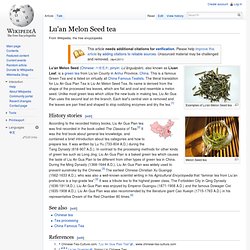
This is a famous Green Tea and is listed on virtually all China Famous Tealists. The literal translation for Liu An Gua Pian Tea is Liu An Melon Seed Tea. Its name is derived from the shape of the processed tea leaves, which are flat and oval and resemble a melon seed. Junshan Yinzhen tea. Junshan Yinzhen (simplified Chinese: 君山银针; traditional Chinese: 君山銀針; pinyin: jūn shān yín zhēn, lit.
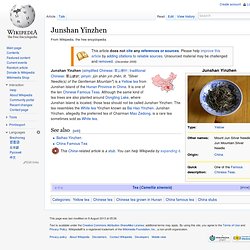
"Silver Needle(s) of the Gentleman Mountain") is a Yellow tea from Junshan Island of the Hunan Province in China. It is one of the ten Chinese Famous Teas. Although the same kind of tea trees are also planted around Dongting Lake, where Junshan Island is located, those teas should not be called Junshan Yinzhen. Keemun tea. Keemun (Cant.: Kei⁴Moon⁴) simplified Chinese: 祁门红茶; traditional Chinese: 祁門紅茶; pinyin: qímén hóngchá; literally "Qimen red tea") is a black Chinese tea with a winy and fruity taste, designated as a China Famous Tea.
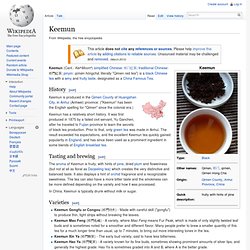
History[edit] Keemun has a relatively short history. It was first produced in 1875 by a failed civil servant, Yu Ganchen, after he traveled to Fujian province to learn the secrets of black tea production. Bai Hao Yinzhen tea. Baihao Yinzhen (simplified Chinese: 白 毫 银 针; traditional Chinese: 白 毫 銀 針), also known as White Hair Silver Needle, is a white tea produced in Fujian Province in China.[1] Amongst white teas, this is the most expensive variety and the most prized, as only top buds (leaf shoots) are used to produce the tea.[2] Genuine Silver Needles are made from cultivars of the Da Bai (Large White) tea tree family.[3] It is important to point out that there are other productions that look similar with downy leaf shoots but most are green teas,[4] and as green teas, they taste differently and have a different biochemical potency than the genuine white tea Silver Needle.[4][5] It is commonly included among the China famous teas.

Production Processing[edit] The fleshy hairs are visible, a unique characteristic of the Silver Needle White Tea A genuine Silver Needle is a white tea. Tasting and brewing[edit] Notes[edit] See also[edit] Thé Oolong. Un article de Wikipédia, l'encyclopédie libre.

Des feuilles de thé Oolong dans un bol. Le thé Oolong ou Wulong (chinois : 烏龍 ; pinyin : wūlóng ; littéralement : « dragon noir ») est un type de thé à oxydation incomplète. Le mot Oolong signifie dragon noir et trouve son origine dans une légende chinoise : un planteur vit surgir un dragon noir d'un théier dont les feuilles ont révélé les notes boisées de châtaigne et de noisette du Oolong.
Ce thé est également désigné en Chine à partir de la couleur de son infusion : il est dit thé bleu-vert. Le Oolong est un thé à l'oxydation enzymatique incomplète (de 12 à 70 %), constitué traditionnellement de feuilles entières, pauvre en caféine. Shui Hsien tea. Shui Hsien (Chinese: 水仙) meaning narcissus or water sprite is an Oolong tea from Mount Wuyi, it has a heavy honey fragrance.
Cheaper varieties are grown elsewhere in Fujian and have a burnt taste and are very popular with Chinese restaurants. The infused color is very dark brown showing that the tea is a very dark Oolong. This tea is also grown in Taiwan. Lao Cong Shui Hsien A Shui Hsien made from old bushes that may be as old as 200 years. Aged Shui Hsien A Shui Hsien that may have been aged for a few decades and rebaked.
Thé noir. Un article de Wikipédia, l'encyclopédie libre. Une tasse de thé noir Un thé noir, ou anglo-indien, est un thé qui a subi une oxydation complète. La plupart des thés consommés en Occident sont des thés noirs, fabriqués selon le procédé « orthodoxe » ou le procédé « CTC », deux modes de fabrication mis au point par les Britanniques au XIXe siècle. Lapsang souchong. Un article de Wikipédia, l'encyclopédie libre. Le Lapsang souchong (en chinois : 正山小种; pinyin : zhèngshān xiǎozhǒng, ou 烟小种; yān xiǎozhǒng), souvent simplement appelé lapsang, est un thé noir originaire de la province de Fujian en Chine.
Ce thé est considéré comme l'un de ceux dont la saveur est la plus marquée. Bien qu'il provienne des feuilles basses de l'arbre, le souchong est classé parmi les thés fins. Comparé aux autres thés noirs, sa période d'oxydation est relativement longue. Pouchong. Pouchong (Chinese: 包種茶; pinyin: Bāozhŏngchá; Pe̍h-ōe-jī: pau-chióng-tê) or light oolong, it is a lightly fermented (oxidized) tea, twist shape, with floral notes, and usually not roasted, somewhere between green tea and what is usually considered Oolong tea (Chinese: 烏龍; pinyin: wūlóng; Pe̍h-ōe-jī: o͘-liông; literally "Black Dragon"), though often classified with the latter due to its lack of the sharper green tea flavours.
It is produced mainly in Fujian, China, and in Pinglin Township near Taipei, Taiwan. Its name in Chinese, literally "the wrapped kind", refers to a practice of wrapping the leaves in paper during the drying process that has largely been discontinued due to advancement in tea processing. At its best, Pouchong gives off a floral and melon fragrance and has a rich, mild taste. Usually around the end of March, begins picking of this famous Taiwan "spring tea" (春茶). Rou Gui. Rougui tea is a Wuyi Oolong tea. The name literally means "cassia". The tea can be difficult to prepare, but its distinctive sweet aroma can be brought out up to 7 steepings. It was first developed during the Qing Dynasty. This tea may be traditionally processed producing a dark dry leaf and a rich smell or processed according to new consumer standards, giving it a leaf of mixed color and a more fruity aroma.
Oolong. Oolong (simplified Chinese: 乌龙; traditional Chinese: 烏龍; pinyin: wūlóng) is a traditional Chinese tea (Camellia sinensis) produced through a unique process including withering under the strong sun and oxidation before curling and twisting.[1] Most oolong teas, especially those of fine quality, involve unique tea plant cultivars that are exclusively used for particular varieties.[2] The degree of oxidation can range from 8 to 85%,[3] depending on the variety and production style.
Oolong is especially popular with tea connoisseurs of south China and Chinese expatriates in Southeast Asia,[4] as is the Fujian preparation process known as the Gongfu tea ceremony. Different varieties of oolong are processed differently, but the leaves are formed into one of two distinct styles. Some are rolled into long curly leaves, while others are 'wrap-curled' into small beads, each with a tail.
The former style is the more traditional of the two in China. Feng Huang Dan Cong. A family of stripe-style oolong teas from Guangdong Province. The doppelganger of teas, Dancong teas are noted for their ability to naturally imitate the flavors and fragrances of various flowers and fruits, such as orange blossom, orchid, grapefruit, almond, ginger flower, etc. As the name implies, Dancong ("single bush") teas are clonal or single-bush productions. Famous Bushes Yu Lan Xiang (玉蘭香 "Magnolia Flower Fragrance") Xing Ren Xiang (杏仁香 "Almond Fragrance") Zhi Lan Xiang (芝蘭香 "Orchid Fragrance") Po Tou Xiang (Ginger Flower Fragrance) Huang Zhi Xiang (黄枝香 "Orange Blossom Fragrance") You Hua Xiang (柚花香 "Pomelo/Grapefruit Flower Fragrance") Mi Lan Xiang (米蘭香 "Honey Orchid Fragrance") Rou Gui Xiang (肉桂香 "Cinnamon Fragrance") Gui Hua Xiang (桂花香 "Osmanthus Fragrance") Other Varietals.
Huangjin Gui. Tieluohan tea. Shui Jin Gui tea. Da Hong Pao tea. Bai Ji Guan tea. Huang Mei Gui tea. Feng Huang Dan Cong. Le thé Oolong ou Wulong. Tea Guardian: Oolongs: What Are They? Most diverse tastes and aromas Fine oolongs make up a tea category of the most diverse tastes and aromas. Theirs are by far the most potent, distinct, and enjoyable in all fine teas.
The various production styles and large range of cultivars give them unique combinations of flavonoids, carbohydrates, amino acids, sugars and essential oils that are not found in other categories. Oolong Tea From Wu Yi Mountain: All Natural and All Good. The Oolong Tea. Upton Tea: brief guide. Vicony Tea Encyclopedia. Tea Habitat. Tea Genius - Tea Information. Yellow Tea Guide.